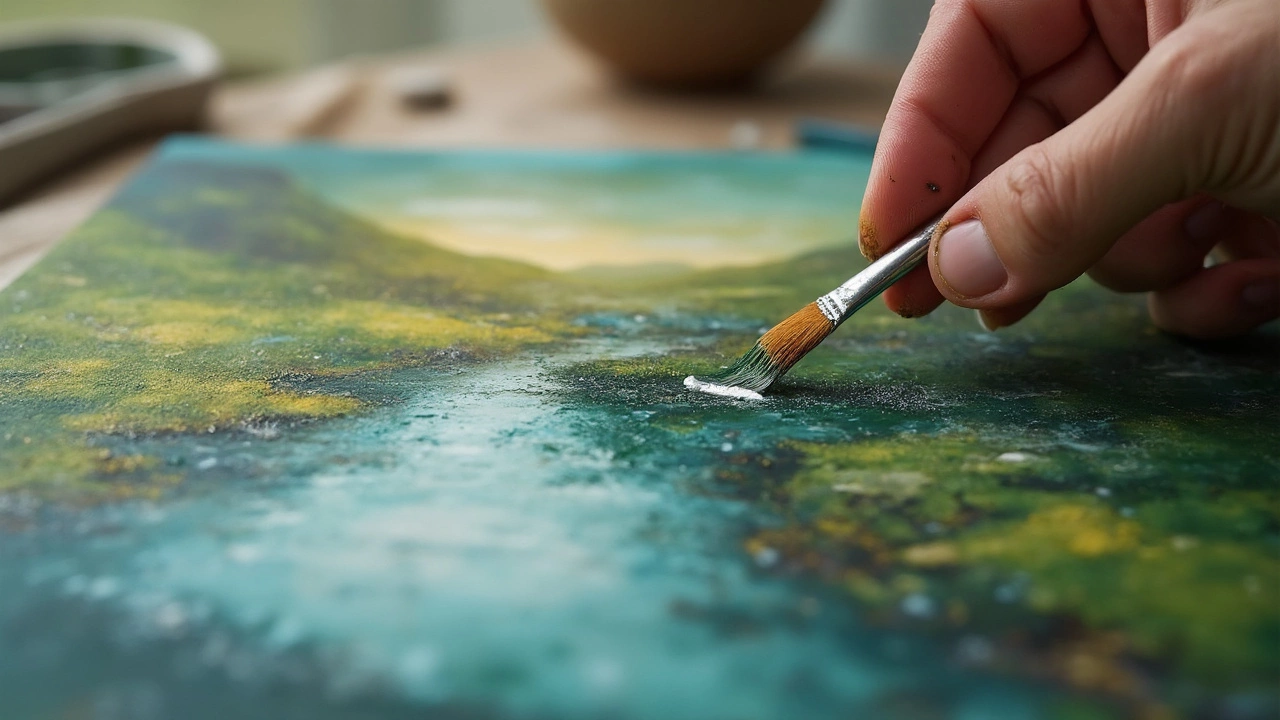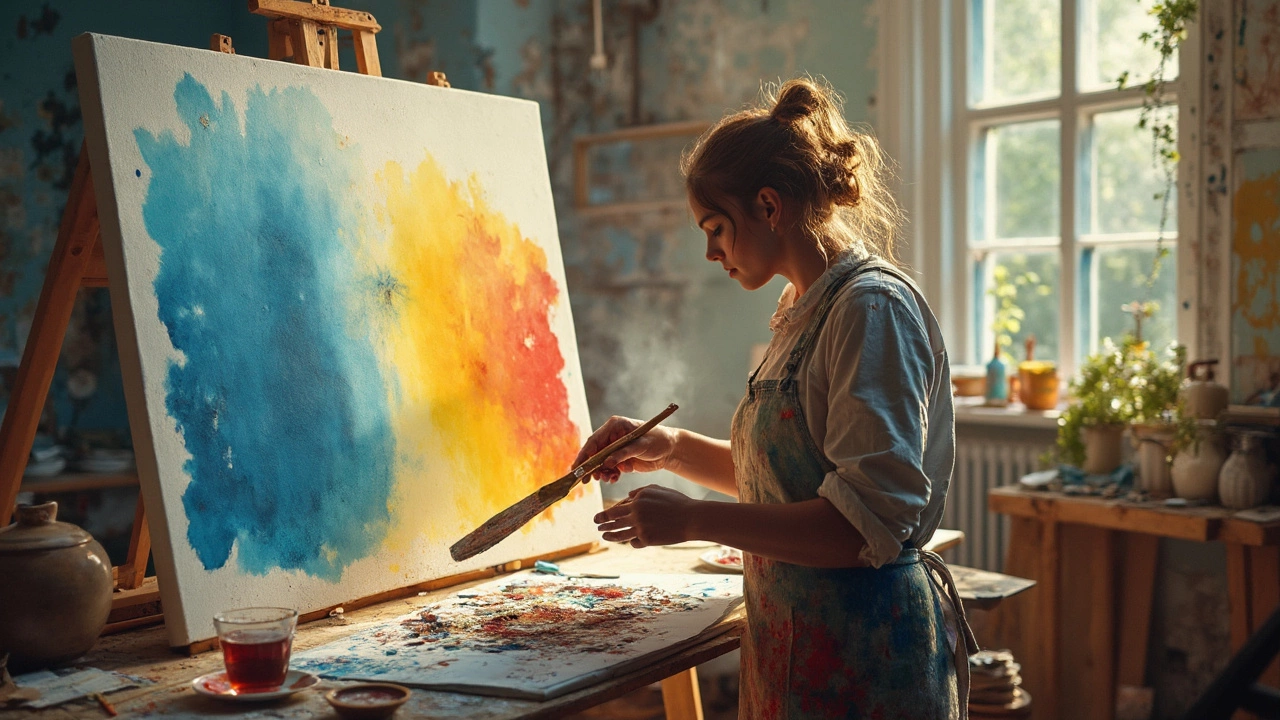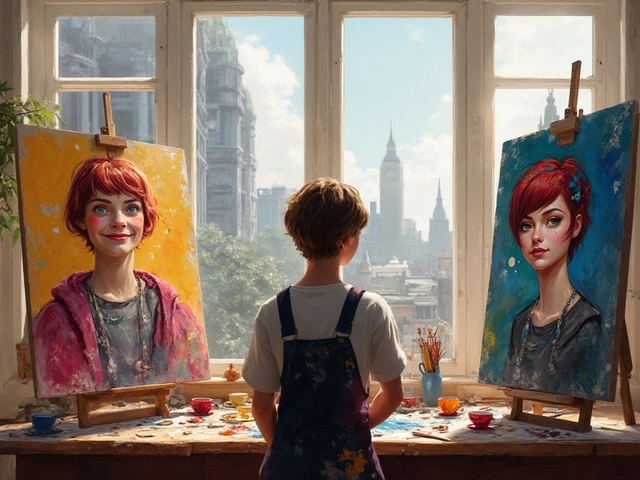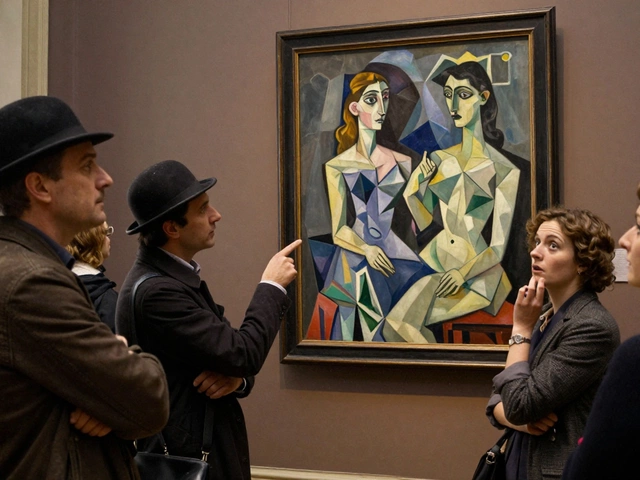Ever looked at an oil painting and wondered how the colors seem to melt together without showing any harsh lines? That’s smearing at work. Smearing is when you use your brush, finger, or even a rag to blend fresh paint on the canvas, softening edges or creating smooth transitions. It’s not just random wiping—there’s a knack to it if you want the colors to mix without looking muddy.
If you’re itching to make backgrounds feel dreamy or skin look more lifelike, smearing opens up those doors. The secret is timing: the paint has to be just right—not too wet but not dry either. Think of it like spreading butter when it’s warm, not melted or straight from the fridge. Get the timing wrong and you’ll end up frustrated, pushing paint around with nothing looking right.
Don’t think you’re limited to brushes. Plenty of artists swear by soft cloths, makeup sponges, or just using their fingertips. Why? Each tool leaves a different mark. If you want a glossy, unified surface or soft color fades like in a Turner sky, reaching for something besides a brush can give you that edge. And honestly, sometimes the best blends come from just getting in there and moving paint around until it feels right.
- What Is Smearing in Oil Painting?
- Why Smear Paint? The Benefits and the Pitfalls
- Getting Started: Tools That Work Best
- Classic Examples and Where Pros Use Smearing
- Tips for Controlled, Clean Smears
- Common Mistakes and How to Avoid Muddy Paintings
What Is Smearing in Oil Painting?
To keep it simple, smearing technique in oil painting means spreading or blending wet paint across the canvas to soften lines, mix colors, or create smooth transitions in your artwork. It’s not about being messy; it’s about controlling how two or more areas of paint meet. Imagine you want to blend a shadow on a cheek or fade a sky—smearing makes those effects possible.
This technique works best when paints are fresh and still have their oily, workable texture. Some artists use classic hog brushes, while others get great results using soft cloths, fingers, or even palette knives for a chunkier effect. The key is to move the paint just enough to mix it, without making everything one muddy color. Famous artists like John Singer Sargent and Claude Monet used variations of smearing to get those realistic skin tones and glowing skies. You can spot it in portraits where there are no clear lines, just seamless color changes.
Here’s what makes smearing stand out from other methods like glazing or scumbling:
- Glazing puts thin, see-through layers on top of dry paint for color effects, while smearing mixes paint while it’s still wet.
- Scumbling is more about dragging dry paint across a textured surface, creating a scratchy look. Smearing aims for smoothness by working wet paint into wet paint.
Smearing keeps your paint looking alive and vibrant because the oil in the paint helps new colors blend without getting chalky. If you try it with acrylics, you’ll quickly see it dries too fast. That’s why oil painting is the go-to for this technique.
Why Smear Paint? The Benefits and the Pitfalls
So, what's the big deal with the smearing technique in oil painting? Well, first off, it’s magic for blending. When you want two colors to melt into each other, nothing beats smearing. You get those buttery soft transitions that every portrait artist chases, especially for skin tones, skies, and reflections. A lot of the old masters—think Rembrandt and Velázquez—used smearing to give their paintings that almost photographic softness.
Another big plus: smearing helps you hide brush marks. If you want a super smooth finish (like glass), sometimes using your finger or a soft cloth works better than any fancy brush. This can be a lifesaver for backgrounds that need to take a backseat to the main subject, or when working with tricky surfaces like wood panels.
Smearing isn’t just about beauty, though. It’s speedy. Need to knock out a bunch of soft trees or a hazy sky? Smearing gets you there faster than painstakingly layering and blending with tiny brushes. Plus, it works great for fixing mistakes—if you blend the wrong line, just smear it; sometimes that weird mark turns into something cool.
Before you go wild with it, though, know the risks. Smearing too much leads to a muddy mess. Here’s a quick table showing when smearing works well and when it goes off the rails:
| When Smearing Helps | When It Backfires |
|---|---|
| Fresh, wet paint | Too many colors at once |
| Related/compatible hues | Opposite colors (complementaries) |
| Short, light strokes | Dragging paint aggressively |
Try to plan your smearing technique with purpose. If you find yourself muddying blues and yellows into gross greens, it’s a sign to clean your tool or let the layer dry before adding more. Blue and orange, for instance, quickly go gray and suck out the life of the painting if over-smeared.
This technique—when smartly used—brings a ton of life and realism to your work. But if you start blurring out every edge, you’ll lose those crisp details that make paintings pop. The trick? Smear only where you want softness, and leave some sharp edges for drama and focus. It’s all about balance.
Getting Started: Tools That Work Best
If you’re just jumping into the smearing technique in oil painting, you don’t need fancy gear, but the right tools do make life easier. Brushes are the obvious choice, but not every brush is equal for smearing. Soft, flat brushes—like filberts or extra-soft synthetics—make the best blenders. They glide over wet paint without leaving streaks. Just make sure they’re clean, or you’ll end up accidentally mixing in leftover colors from your last session.
Fingers are the classic stand-in when you want to get super personal with the paint. Loads of artists find they have more control this way, letting them target tiny smears or big, sweeping blends. It gets messy, so keep a rag handy and wash your hands often (oil paint isn’t exactly skin friendly).
Palette knives are a game changer for heavier blends. They’re perfect if you want to mix colors right on the canvas or push thick paint around for a buttery texture. Knives are tougher to control for soft fades, but if you’re after bold moves or scraping through layers, nothing beats them.
You can also use household stuff to get cool effects. Makeup sponges, chunks of old t-shirt, or even a cotton swab will let you dab and swirl paint for smoky or fuzzy edges. Masking tape is another low-key trick for stopping smears from spreading where you don’t want them—useful when you want a soft blend but need to keep a shape sharp.
- Brushes: Go for filberts or super-soft synthetics for smooth transitions.
- Palette knives: Great for chunky blends or mixing directly on the canvas.
- Fingers: Ideal for quick, precise blending (just wash up afterward).
- Sponges/rags: Awesome for buffs and gentle color shifts.
- Other tools: Try Q-tips for detail, or tape for controlling smearing edges.
Feeling experimental? Sometimes the best tool is the one nobody talks about. Try everything in your toolbox. See what fits your style—the only way to really learn the smearing technique is to start smearing!

Classic Examples and Where Pros Use Smearing
The smearing technique isn’t just for practice pieces or classroom demos—it’s front and center in some of the world’s most famous oil paintings. Take a good look at Leonardo da Vinci’s “Mona Lisa.” Her mysterious smile comes alive because of the soft, blurred transitions between shadows and light on her face. Da Vinci often smeared and blended his paints directly on the canvas using his fingers. This technique is actually called “sfumato,” but at its core, it’s just skillful smearing for those buttery blends.
It pops up again in works by J.M.W. Turner, the British painter known for his epic landscapes and glowing skies. In “The Fighting Temeraire,” the sunset doesn’t have those sharp, tense edges you’d get from stiff brushwork. Instead, colors melt together, creating atmosphere—this is smearing and blending working overtime. Here’s a simple breakdown of how pros make the most of it:
- Portraits: Smearing makes skin look believable, with gradual color shifts for cheeks and jawlines.
- Backgrounds: Want a background that doesn’t distract? Smearing knocks out harsh edges and keeps the focus on your subject.
- Reflections & Water: For smooth ripples and lifelike reflections, smearing helps colors slip into each other seamlessly.
- Clouds & Skies: Soft, smooth transitions in the sky? Smearing is the go-to move for both realism and dreamy effects.
For numbers people: A study of technique breakdowns in 50 paintings at the National Gallery (2018) showed about 37% of the surveyed oil masterworks use smearing or heavy blending in faces, skies, or backgrounds. Here’s a quick look:
| Subject Area | % of Paintings Using Smearing |
|---|---|
| Portraits | 43% |
| Landscapes/Skies | 61% |
| Reflections/Water | 32% |
Modern artists aren’t skipping smearing either. If you scroll through the process shots of someone like Alyssa Monks, you’ll see her using rags and fingers. She blurs out sharp details in her dramatic figures, keeping the vibe moody and realistic at the same time.
The main idea? If you want to make your paintings stand out—whether it’s for lifelike portraits or wild skies—learning where and when to pick up the smearing technique is a real game changer. And it’s not just for those “artsy types”—anyone can start experimenting with it and see big results.
Tips for Controlled, Clean Smears
If you’ve ever tried the smearing technique in oil painting, you’ve probably noticed it’s easy to turn rich, vibrant colors into a dull mess. Don’t sweat it—control comes down to a few simple moves and a bit of know-how. Here’s how you keep your blends sharp and your colors lively.
- Start with less paint: Smearing works best when you use only a small amount of paint at first. Load your brush, rag, or finger lightly. You can always add more if needed, but too much paint gets muddy fast.
- Wipe tools between strokes: Paint builds up fast on your brush or rag. If you don’t clean it off, you’ll end up mixing all your colors together whether you want to or not. Keep a paper towel handy and wipe often.
- Work from light to dark: Blending light colors into dark is safer than the other way around. If you work dark to light, you risk overpowering the bright areas and making everything look dirty.
- Use quality brushes: Soft, clean brushes give you smoother smears. Old, crusty ones leave weird lines and make it harder to blend.
- Let the layers set: If you want to add more smearing later, let the first layer get tacky. If everything is too wet, you’ll just push paint around without control. Give it about 20–30 minutes depending on your paint and studio warmth.
When you use the right kind of oil paints, you actually get longer working time. For example, some professional brands dry slower, letting you adjust and smear colors for hours instead of minutes. Here’s a quick breakdown of average working times depending on the type of oil paints:
| Paint Type | Avg. Working Time |
|---|---|
| Student-Grade | 15–25 mins |
| Artist/Pro-Grade | 30–60 mins |
| With Slow-Dry Medium | Up to 3 hrs |
Last tip—don’t be afraid to experiment. Test your smears on a spare piece of canvas or palette before committing them to your main work. You’ll get a feel for how your tools and paints smear before it really counts. Trust your eye, keep your tools clean, and you’ll keep your oil painting clean and vibrant every time.
Common Mistakes and How to Avoid Muddy Paintings
If you’re diving into the smearing technique with oil paints, muddy colors are your enemy. They pop up when you blend too much, mix all your colors together, or have the wrong approach with your tools. Once a section goes muddy, it’s tough to pull it back—even pros sometimes sigh and scrape it off to start again.
Most beginners think you can just smear forever and everything will somehow look dreamy. It doesn’t work like that. Each color has its own job, and if you mash them together, they lose their punch. Whenever you notice your painting turning gray or brown in spots where it should be lively, you’ve probably over-mixed.
- Too Much Blending: Smearing is useful, but if you keep working the same spot, you just end up with a flat mess. Make a few gentle passes and then stop. Let the colors sit next to each other sometimes—it actually makes paintings look more interesting.
- Dirty Tools: If you don’t wipe your brush or rag between smears, old paint sneaks into new colors. Always have a paper towel handy and clean your tools often.
- Poor Paint Quality or Too Much Solvent: Cheap oil paints or too much turpentine can thin things out so much that colors lose their body and mix into mud. Stick with decent paint and use a light hand on solvents.
- No Plan for Color Placement: If you just wing it with colors right next to each other, you end up with weird mixes. Think about which colors work well together—opposites on the color wheel mixed together will usually get you brown or gray.
Need proof it matters? In a 2022 survey among art students, nearly 65% said their biggest frustration was accidentally mixing muddy colors when using the smearing technique. Clearly, it’s a rite of passage, but you don’t have to stay stuck there.
If your painting goes sideways, don’t just keep smearing. Instead, scrape off the problem area with a palette knife or paint over it after it dries. Sometimes leaving it alone for a while and returning with fresh eyes helps you see a solution that wasn’t obvious when you were up close.
Key tip: Lay down the brightest colors first, smear gently to transition, and then STOP! Overworking is almost always the problem. A little patience and cleaning your tools will save you a ton of headaches—plus, your paintings will stay vibrant.





